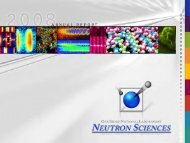Inelastic X-Ray Scattering - University of Illinois at Urbana-Champaign
Inelastic X-Ray Scattering - University of Illinois at Urbana-Champaign
Inelastic X-Ray Scattering - University of Illinois at Urbana-Champaign
You also want an ePaper? Increase the reach of your titles
YUMPU automatically turns print PDFs into web optimized ePapers that Google loves.
I<strong>Inelastic</strong> l i X‐<strong>Ray</strong> X R <strong>Sc<strong>at</strong>tering</strong> S i<br />
N<strong>at</strong>ional School on X‐<strong>Ray</strong> and Neutron <strong>Sc<strong>at</strong>tering</strong><br />
AArgonne NN<strong>at</strong>ional i lLb Labor<strong>at</strong>ory, JJune 2010<br />
Peter Abbamonte<br />
<strong>University</strong> <strong>of</strong> <strong>Illinois</strong> <strong>at</strong> <strong>Urbana</strong>‐<strong>Champaign</strong><br />
abbamonte@mrl abbamonte@mrl.uiuc.edu uiuc edu<br />
http://users.mrl.uiuc.edu/abbamonte/
<strong>Inelastic</strong> x‐ray sc<strong>at</strong>tering – technical<br />
Nonresonant inelastic x‐ray sc<strong>at</strong>tering<br />
Resonant inelastic xx‐ray ray sc<strong>at</strong>tering (RIXS)<br />
(Lorentz force law)
Nonresonant IXS<br />
“N “Nonresonant” t” inelastic i l ti x‐ray sc<strong>at</strong>tering tt i<br />
Dynamic structure factor:<br />
k k f kifi<br />
S(k,) is the Fourier transform <strong>of</strong> the Van Hove density correl<strong>at</strong>ion function:<br />
X X‐ray “diff “diffraction” ti ” actually t ll measures an equal‐time l ti correl<strong>at</strong>ion lti function f ti<br />
t0<br />
<br />
S( k, ) d G( k, t) dxG( x,0)<br />
e<br />
ikx
Nonresonant IXS – dynamics!<br />
(x 1,t 1)<br />
(k 1, 1)<br />
(x 2,t 2)<br />
1 1<br />
S(<br />
, ) Im ( , )<br />
/ kT<br />
1 e <br />
k <br />
k <br />
<br />
<br />
<br />
i<br />
( x, ) nˆ( x,<br />
t), nˆ(0,0) (<br />
t)<br />
<br />
Fluctu<strong>at</strong>ion‐dissip<strong>at</strong>ion<br />
theorem<br />
Retarded density<br />
Green’s function<br />
(k 2, 2)<br />
Describes how charge propag<strong>at</strong>es around a system:<br />
• Phonons<br />
• Plasmons<br />
• Excitons<br />
• Band structure<br />
• Etc.
Resonant IXS (RIXS) –physical picture?<br />
Vl Valence<br />
electrons<br />
core level (1s)<br />
• Coherent two‐step p process p (absorption ( p / emission) )<br />
• Denomin<strong>at</strong>or can diverge. More intense.<br />
• Polari Polariz<strong>at</strong>ion‐dependent; <strong>at</strong>ion dependent sensiti sensitive e to symmetry s mmetr <strong>of</strong><br />
excit<strong>at</strong>ions<br />
• Couples to many types <strong>of</strong> excit<strong>at</strong>ions (magnons?)<br />
• No causality ‐ cross section not rel<strong>at</strong>ed to a<br />
correl<strong>at</strong>ion function. Often hard to decipher.
Comparison to other techniques<br />
<strong>Inelastic</strong> Neutron <strong>Sc<strong>at</strong>tering</strong><br />
• Low energy probe ( i = 25 meV)<br />
• Better energy resolution<br />
• Couples only to nuclei and spins<br />
• Not sensitive to charge excit<strong>at</strong>ions<br />
(e.g. plasmons)<br />
• Large samples required<br />
<strong>Inelastic</strong> Electron <strong>Sc<strong>at</strong>tering</strong><br />
• Can focus beam ~ 1Å<br />
• Decent energy resolution (0.5 eV)<br />
• Sample damage<br />
• Multiple sc<strong>at</strong>tering<br />
• Does not work in H 0<br />
• Requires UHV<br />
Light (Raman) <strong>Sc<strong>at</strong>tering</strong><br />
• q=0 probe<br />
• Super high energy resolution (0.1 meV)<br />
• Super high flux (10 22 photons/sec on sample)<br />
• Polariz<strong>at</strong>ion selection rules<br />
• cheap
Advantages / disadvantages <strong>of</strong> IXS<br />
<br />
•Direct coupling to charge excit<strong>at</strong>ions<br />
•High h resolution l ( (
Instrument<strong>at</strong>ion: Overview<br />
k ki k k2 2 2<br />
q = k k1 – k k2 White beam from APS undul<strong>at</strong>or<br />
Requirements / Challenges<br />
• Cross section small: only 1 in 10 8 photons are inelastically<br />
sc<strong>at</strong>tered –high flux needed<br />
• Very high resolving power needed. 2 meV / 20 keV = 10 ‐7<br />
• Must be able to tune energy; both 1 and 2 for RIXS<br />
• Broad angular acceptance required for enough signal<br />
MMonochrom<strong>at</strong>ic h ti<br />
beam<br />
sc<strong>at</strong>tering angle<br />
Specimen<br />
Backsc<strong>at</strong>tering k i<br />
analyzer
Instrument<strong>at</strong>ion: Source<br />
Spring‐8 (Hyogo, Japan)<br />
ESRF (Grenoble, France)<br />
Advanced Photon Source<br />
(Chicago, IL, USA)
Instrument<strong>at</strong>ion: Source<br />
Sector 9<br />
Electronic<br />
excit<strong>at</strong>ions / RIXS<br />
Sector 3<br />
Phonons<br />
Sector 30<br />
Both
Instrument<strong>at</strong>ion: Sector 30 XOR‐IXS Spectrometers<br />
MERIX<br />
E = 10‐100 meV<br />
El Electronic t i excit<strong>at</strong>ions: it ti<br />
• plasmons<br />
• excitons<br />
• Mott Mott‐gap gap excit<strong>at</strong>ions<br />
• two‐magnons<br />
HERIX<br />
E = < 1 meV<br />
Vibr<strong>at</strong>ion modes:<br />
• acoustic phonons (sound)<br />
• optical phonons
Instrument<strong>at</strong>ion: Monochrom<strong>at</strong>or<br />
Bragg’s gg law:<br />
2d sin = <br />
<br />
bandpass<br />
Darwin<br />
width idth<br />
Dumond<br />
diagram<br />
<br />
Tunable by<br />
rot<strong>at</strong>ing i crystals l<br />
in a coordin<strong>at</strong>ed<br />
fashion.
Instrument<strong>at</strong>ion: Analyzer<br />
• Need “curved” crystal to accept<br />
large <br />
• Mosaic <strong>of</strong> ~10 4 aligned blocks<br />
• Glued on spherical surface<br />
• Used near backsc<strong>at</strong>tering<br />
• Slightly tunable by rot<strong>at</strong>ing angle<br />
Backsc<strong>at</strong>tering
IXS Example 1: Excitons<br />
B. C. Larson, et. al., Phys. Rev. Lett. 99,<br />
B. C. Larson, et. al., Phys. Rev. Lett. 99,<br />
026401 (2007)
IXS Example 2: Plasmons in graphite and graphene<br />
A. H. Castro‐ Neto, et al., Rev. Mod. Phys. 81, 109 (2008)
IXS Example 2: Plasmons in graphite and graphene (x,t)<br />
i<br />
( x, ) nˆ( x,<br />
t), nˆ(0,0) (<br />
t)<br />
<br />
J. P. Reed, et al., submitted<br />
(0,0)
RIXS Example 1: Crystal field excit<strong>at</strong>ions in SrCuO 2<br />
AA. Higashiya et et. al., al J. J Elect. Elect Spect Spect. Rel Rel. Phen Phen. 144 144‐147, 147 685 (2005)
RIXS Example 2: Magnons in La 2CuO 4<br />
JJ. P. P Hill, Hill et. et al., al Phys. Phys Rev. Rev Lett. Lett 100 100, 097001 (2008)
The Future<br />
• Join mainstream <strong>of</strong> experimental probes (with STEM, ARPES, etc.)<br />
• Imaging<br />
• Strip detectors (no more analyzers?)<br />
• Surface dynamics [B. Murphy, et. al., Phys. Rev. Lett. 95, 256104<br />
(200 (2005)] )]<br />
• High g ppressure (fluctu<strong>at</strong>ions near quantum q phase p transitions)<br />
• ??? New ideas from new people.

















